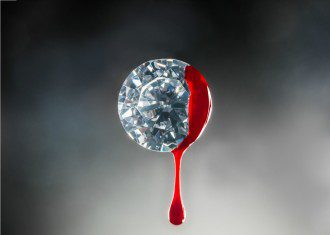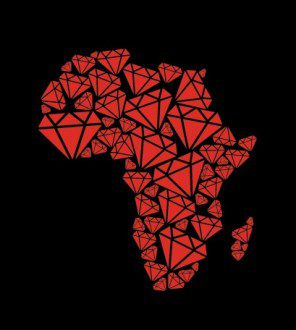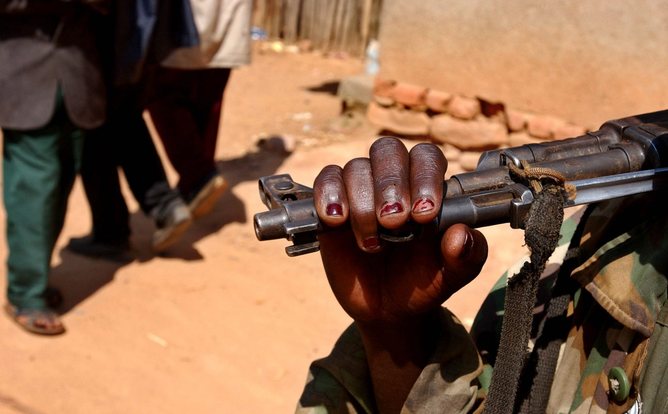By Irwin Ozborne
Contributing writer for Wake Up World
“For every hand in marriage, another hand is taken away. For every finger to receive a ring, another finger must pull a trigger.”
We all know the story. It is the classic love story. The man gets down on one knee, grabs hold of the girl’s hand and she covers her mouth as she is overtaken by emotions. The man pulls out a tiny box and opens it up to show off the sparkling diamond engagement ring before asking the question, “Will You Marry Me?” They are officially engaged once he pops a diamond ring on her finger.
However, there is another side to this story that never gets covered in the media. It is the dark side of the diamond. And if the public knew about the horrors and atrocities that take place to produce this mineral, perhaps we would re-think the way we celebrate “love”.
The Human Price of Diamonds is Blood
Diamonds are considered a timeless, beautiful, symbol of love. As the popular slogan of the cartels has simply claimed, “A Diamond Is Forever.” They are the world’s most precious gems, and among the most expensive. But the astronomical prices paid to jewelers to possess these beautiful gems is nothing compared to the ultimate price paid by those who mine those diamonds, another world away.
[pro_ad_display_adzone id=”110028″]
As the love story above tells us, the consumer purchases the diamond and then uses it to surprise the love of his life in a romantic, fairy-tale ending. But, where does the story of the diamond begin?
Similarly, someone reaches out their hand… But this is the outstretched hand of a villager in a remote area in West Africa. He also has all his friends and family nearby as the anxiously wait. However, it is not to put a ring on his finger; instead combatant rebels are about to amputate his hand to ensure the man is not allowed to vote or be involved in politics, as well as spreading fear throughout the village — to ensure the villagers comply with the local rebel militia who operate the diamond mine.
In a different Southern Africa town, a 14-year-old girl knocks on the door of a civilian’s home before pulling out a gun, and a group of rebels raid the home. They steal everything valuable, abduct the woman’s children and executing her in front of their mother.
In Central Africa, another 15-year-old girl has been living in a pit in the ground from which she is brought up each day, only to be raped by a combatant. She becomes pregnant but still endures daily sexual abuse before being dropped back into her hole in the ground, where she lives next to the corpse of her best friend who was killed three weeks prior.
All these stories are true, and they are the direct result of the illicit diamond trade.
The sale of diamonds from these rebel militia groups funds civil wars in a number of African nations, as diamonds are exchanged for weapons. Civil wars have been fought in Sierra Leone, Liberia, Angola, and the Democratic Republic of the Congo. More than four million lost their lives, many more displaced, and hundreds of thousands suffered varying level of war crimes including intentional mutilation/amputation and rape. All of these wars were funded by the same currency – diamonds.
And, as these horrendous acts have been carried out for decades, the West turns a blind eye to the origins of the ‘blood diamonds’ they are flossing on their fingers and showing off to their friends and family.
While blood diamonds initially found their way into the global market in the 1990s, it wasn’t until the mid-2000s that people started becoming aware of the blood that was being shed in the name of producing and supplying diamonds to the west. Since then, the diamond industry — like all industries that exploit cheap slave labor in vulnerable developing nations — initiated a few cover-up operations that create the illusion that their products come from non-conflict areas. However, even “non-conflict” diamonds come from one of the most corrupted industries in the history of the world. This diamond industry has developed one of the greatest marketing schemes in the world, which has us believing that love is synonymous with diamonds, and leaving the world turning its collective head to the crimes against humanity that are routinely carried out — to bring us the gems we believe we need to properly express romantic, marital love.
How many times will a man turn his head and pretend that he just doesn’t see?
The answer my friend, is blowing in the wind. The answer is blowing in the wind.”~ Bob Dylan
The Diamond Marketing Scheme
Diamonds were first discovered 2,500 years ago and, at the time, were extremely rare. They were only available to royalty, aristocrats, and the wealthy. They were originally found in riverbeds in India and Borneo.
In the early eighteenth century, diamond mines were found in Brazil and as the supply increased the prices dropped.
In 1866, a 15-year-old boy found diamonds on his father’s farm on the banks of the Orange River in South Africa. Within fifteen years, African mines became the leading producer of diamonds and the industry was changed forever.
A mining rush ensued and industrial mining for diamonds had begun.
Cecil Rhodes, an English imperialist, whose thirst for power and quest to spread the British way of life across the globe stumbled upon the diamond mine on the De Beers farm and purchased it for a small price. Rhodes feared that if all these diamonds hit the market, the prices would crash. His goal was to then control the market by securing and regulating the supply. So, one by one, he bought out the other mining companies and founded De Beers Diamond and Mining Company.
By 1888, Rhodes had control of 90-percent of the diamonds in the world, which meant he was able to ensure there would never be a flood of supply to lower prices. He also had been named Prime Minister of Cape Colony, giving him the political power to enforce laws that would pave the way for Apartheid, by removing natives off their land and into forced labor camps to mine his diamonds. In effect, The De Beers Company had created a cartel that was based on the French concept of controlling the copper industry – buying up mines, restricting supply, and raising prices.
(A cartel, by definition, is simply an agreement between competing firms to exclude prices and exclude entry of a new competitor into the market – a practice that, although prevalent, is illegal under both United States and United Nations law.)
De Beers largest competitor, the Anglo American Company, was founded in 1917 by Ernest Oppenheimer. Oppenheimer had stumbled upon massive amounts of alluvial diamonds, which are found on top of the earth and do not need to be mined. Thus, Oppenheimer threatened to flood the market with these diamonds unless he was made chairman of De Beers. And just like that, the illegal anti-trust monopoly was created with complete control of the industry.
[pro_ad_display_adzone id=”110030″]
Now that supply was under full control, the De Beers company focused on taking charge of the other side of the business equation – demand.
The cartel then set up an office in Hollywood and exchanged valuable diamonds to film producers as payment for including scenes in their films that showed off diamonds, particularly images of men surprising women with diamonds. This direct marketing propaganda helped to launch the notion that equated engagement with receiving diamonds. The cartel also provided them to actresses to flaunt at public appearances, as further means of advertising to the public.
This was followed-up with a marketing campaign with the simple phrase, “a diamond is forever.” This in turn trained the public to believe that love is synonymous with diamonds, which saw people willing to pay large portion of their salaries to show love for their significant other. (DeBeers initially promoted a ‘rule of thumb’ equivalent to 3 months’ salary but scaled it back to 1 month’s salary when sales dropped during the Depression era.)
“The diamond market is dependent for its smooth function on the maintenance of the illusion in the minds of the general public that the diamond is a rare and valuable stone.” ~ De Beers mining engineer, 1930
Furthermore, “A Diamond is Forever” also suggests that diamonds there is no resale value of diamonds — that they are, like love itself, invaluable — and that every woman therefore deserves her own unique diamond to symbolize your eternal love for her, thus preventing diamonds from returning to the market, which again raises prices.
While this sounds like a brilliant marketing scheme; this false concept of diamonds being ‘rare and valuable’ has led to millions of lives being slain and forced into manual labor, while setting up the foundations for Apartheid and the brutal civil wars that occurred over the following century.
The Takeover of Africa
In the late 1880s and 1890s, the European nations got together and literally drew up a new map of Africa. Drawing imaginary lines through the landscape of the continent, they sketched out which European nations would own certain parts of Africa. They were claiming possession of lands they had never seen.
As the colonial powers’ fleets came ashore all the African lands, they soon put the natives to work, plundering all the natural resources including tin, copper, rubber, gold, diamonds, cobalt, ore, oil, etc. By doing so They had recreated a different form of slavery and a rise to Western capitalism. Thus the European Industrial Revolution was born — entirely dependent upon cheap resources from Africa.
All of this was done under the false pretense of bringing Christianity and “civilization” to the natives – eerily similar to the conquest of the Americas a few centuries prior. (See: Celebrating Genocide – Christopher Columbus’ Invasion of America.) And while the European nations flourished off the rich natural resources of Africa, the African continent remained poor and enslaved to western forces.
After World War II the rise of African Nationalism took place and the anti-colonialism movement began. By the 1960s, one by one, the African nations were granted their freedom, due only to the European nations lacking the money to continue to operate as oppressive empires against the anti-colonial movement.
The next obstacle for Africa was the Cold War. Just like the Europeans did previously, the United States and the Soviet Union started dividing up the world into Capitalists vs. Communists territories. Any African nation that supported nationalizing their own natural resources was soon deemed communists, and opposing American-backed rebel groups were created in the name of “freedom.”
Once the Cold War ended in 1989-90, money stopped flowing into these war zones and the rebel groups needed funding. There was still an ample supply of valuable natural resources within Africa, and the brutal civil wars were then funded by illegally selling raw materials to the global market. Hence, the consumers of those materials funded the most brutal civil wars in modern history.
The three countries most ravaged by the illegal diamond trade were Sierra Leone, Angola, and the Democratic Republic of the Congo. While the rich made enormous profits from exploiting these countries, the citizens still live in some of the least desirable conditions on Earth.
Selling Out Sierra Leone
Sierra Leone is one of the richest in natural resources with some of the most sought after diamonds. This discovery should have helped the nation prosper, but instead brought conflict and one of the most diabolical wars in history – and one that your history books and media never share. As a result, Sierra Leone is one of the financially poorest countries on Earth.
Located on the western shore in northern Africa, Sierra Leone was a main area for the slave trade in the 1800s. British ships would exchange arms for slaves before shipping the slaves to the ‘New World’. The slaves would work on land stolen from Native Americans in labor-intensive jobs such as cotton and tobacco agriculture; two two industries that made America one of the wealthiest nations on Earth.
In 1961, Sierra Leone was liberated from Great Britain, and their economic prospects looked good with the newfound discovery of alluvial (surface) diamonds in 1930. They nationalized the diamond industry which should have allowed for enormous economic growth, however all it brought was corruption as the nation’s new leaders brought in shady characters to run the diamond industry. As a result, diamond exports dropped from $200-300 million dollars per annum to practically nothing.
In turn, funding for social services soon evaporated, leaving no money allocated for education or health care, and the entire infrastructure collapsed. Soon the press was restricted to not allow the outside world to see inside the corruption of the new government. This didn’t take long for young students to become ‘radicalized’ by this experience, and formed an opposition rebel movement known as the RUF (Revolutionary United Front).
The RUF was led by Foday Sankoh, who promised to help the impoverished for a greater share in the mineral wealth that was misused by the corrupt government. But instead, he started ordering the brutal tactics of daily sexual assault, mutilations and amputations against the same peasants he was claiming to protect.
Civil War broke out in 1991 in Sierra Leone and the RUF took control of the diamond mines, which not only brought in arms for the rebels but limited the Sierra Leone government’s ability to finance a military, and citizens could not be protected.
The diamond mines were turned into labor camps in which young children worked day and night at gun point. If they attempted to rest, eat something, or were suspected of stealing diamonds, they were killed instantly.
The diamonds were smuggled across the border to Liberia, who was run by fellow war-criminal, Charles Taylor. Notably, Liberia became one of the top countries for diamond exports in the 1990s, with more than two billion dollars worth of diamonds exported each year, despite the fact that Liberia does not have the resource capability to even produce 10 million dollars worth of diamonds. And, while the world market saw this influx of diamonds from Liberia, nobody blinked an eye. Industry and world leaders knew these were blood diamonds, but they turned their heads as these gems piled into the global market — at the expense of innocent lives.
It is estimated that in the 1990’s, one in every five diamonds sold worldwide came from a conflict area. Meanwhile, the United States became the largest market for diamonds, consuming more than 40 percent of all diamonds in an industry that sells $72 billion worth of diamonds per year.
Child Soldiers + Amputations + Rape = Vice Presidency
Eventually the United Nations stepped in and a president was elected in Sierra Leone, who agreed to negotiate with the rebels. However violence ensued because Sankoh wanted political power as well as control of the diamonds. Soon, the rebels started amputating arms and hands of civilians as a message, to ensure they would not vote again. They would ask if civilians wanted “Short sleeves or Long sleeves” referring to where they would sever their arm – either at the wrist or elbow.
Young boys and girls started to be abducted to further the cause of the RUF. There were more than 20,000 child soldiers between the ages of 7-12 that were taken from their homes and knew no family other than the rebels that trained them to kill. They were fed drugs and alcohol to become more violent and compliant, and were even known to rob from their own families. Young girls were recruited to be cooks, sex slaves, and soldiers.
In 1997, the rebels took over Freetown in what they referred to as “Operation Pay Yourself.” They went house-to-house, ravaging the city and slaughtering civilians. The streets of the capital were lined up with corpses of civilians stuck in the middle of the world’s most vicious civil war. Eventually, the US and UN stepped in around 1999 and had the parties at war come to a peace agreement, known as the Lome Peace Accord.
The agreement was for the RUF to surrender the fighting in exchange for their share in the Sierra Leone Government. This allowed for Sankoh to be released from a death sentence and handed the keys to the Vice Presidency of the country. That’s right; the man who committed the most atrocious acts was named Vice President of the people he tortured for one decade. He was also left in charge of the diamond fields – the two things he wanted but could never achieve through war and violence.
Additionally, amnesty was granted to all fighting forces. This meant that rebels and civilians were now living side-by-side as if nothing had ever happened. Nobody could be charged for war crimes besides those who had been in power to carry out the most heinous crimes.
While the war ended in 2002, it has destroyed a nation that now has to “forgive” the perpetrators of war crimes, instead of seeing justice. Furthermore, there are still people working for less than a dollar a day in the diamond mines, producing diamonds that make their way into neighboring countries to be sold into the world market. Furthermore, the alluvial diamonds are still there, creating an ongoing threat of a further uprising.
Angola, the Pawn
Angola was one of the last African nations to be granted independence by its colonial power when they were liberated from Portugal in 1975. But liberation did not equal freedom as three different groups suddenly fought for control over the Angolan government.
Just like many nations in the Cold War era, one side of the conflict was funded by the Soviet Union and the other by the United States. While the superpowers played a game of chess over Angola, the end of the Cold War left a market of alluvial diamonds which were traded for arms, allowing the war to continue. The nation was faced with extreme poverty, a refugee crisis, millions of deaths, and an estimated 10 to 20 million land mines spread out throughout the land.
Angola diamonds are some of the best in the world, the ones that the world desires most. More than $3.7 billion worth of diamonds were sold from the rebels into the world market in the 1990s.
In 1998, the UN placed a ban on non-government sanctioned diamonds, but there were zero attempts at actually carrying this ban out. The Angola government had purchased diamonds from UNITA (a rebel group supported by the United States) which would then be exported as their own, with both parties profiting off blood diamonds. And all along, it was diamond consumers in the West who were unknowingly funding this two-decade civil war.
A Precursor to Apartheid
What about non-conflict diamonds? Is there such a thing?
Cecil Rhodes, the founder of the diamond cartel, was an imperialist racist who paved the way for Apartheid. He was a perpetrator of genocide, responsible for the displacement of millions of Africans for the benefit of white settlers, and for the enslavement of African people on their own land.
Rhodes, in 1887, told the House of Assembly in Cape Town that:
“… the native is to be treated as a child and denied the franchise. We must adopt a system of despotism in our relations with the barbarians of South Africa”.
In less oratorical moments, he put it even more bluntly:
“I prefer land to niggers.”
Rhodes also notoriously stated:
“I contend that we are the first race in the world, and that the more of the world we inhabit the better it is for the human race. Just fancy those parts that are at present inhabited by the most despicable specimen of human being, what an alteration there would be in them if they were brought under Anglo-Saxon influence… If there be a God, I think that what he would like me to do is paint as much of the map of Africa [as] British Red as possible…”
In 1890, Rhodes became the Prime Minister of Cape Colony. He soon passed laws that became a precursor to Apartheid. The Glen Grey Act limited the amount of land that Africans could hold and also tripled the property qualifications that enabled Africans to be able to vote – hence, making it literally impossible for Africans to be involved in their own domestic politics. He also introduced the “Native Bill” in 1894 as a colonial taxation of African people, to force them to work as near slave labor in the diamond mines. Further racist laws enabled the cartel to control workers, keep wages very low, and gain immense profits from the diamonds and gold that black miners extracted from the earth. Many African men worked on the mines and farms under dangerous conditions for wages that could not sufficiently feed and clothe their families. They also required black men to carry documents that identified where they could and could not work and live — a law that continued under Apartheid.
War Diamonds
Aside from consumer diamonds, there are also industrial diamonds used to manufacture weapons and arms for military purposes. During the time of World War II, De Beers denied the United States access to large quantities of industrial diamonds. They feared that diamond prices would fall if stockpiles of industrial diamonds entered the market after the war. So, rather than help the United States (an ally of United Kingdom and South Africa) in war, De Beers protected its profits.
At the same time, the Nazis were accumulating large supplies of diamonds smuggled into Hitler’s possession. It was believed Hitler had only eight months’ supply of industrial diamonds and would soon run out if it were not for illicit smuggling through the Congo. The only way to ensure the smuggling stopped was for De Beers to shut down their mine, to guarantee there was no leakage. However, again, De Beers chose that it was more important to make profits than to deter acts of war, and continued to operate the mine knowing that there would be leakage that helped facilitate the Nazi war and, because of this, millions more people lost their lives.
After the war, De Beers’ influence shut down any attempts at a formal investigation.
Yet, during the war, De Beers advertisements encouraged consumers to buy their diamonds for patriotic reasons — because they produce the same diamonds that Americans needed to win the war.
Kimberly Process
After the blood diamonds industry was exposed to the world in the 1990s, the industry had to respond — not because they now cared, but because they feared that consumers would protest. They implemented the Kimberly Process in 2003, which is a system of certifications through which jewelers are able to validate their diamonds as “non conflict diamonds.” But there are a few problems with this process…
First, it does not allow for third-party reviews. It is all done internally by the same industry that has been corrupted by greed for the past 125 years. Industry self-regulation is also voluntary with no provisions for audits. Also, there are more than 180,000 diamond diggers that are not licensed, and it is impossible to know where the diamonds are coming from unless an inspector is physically at every site.
An online documentary shows a couple of journalists who followed the trail of blood diamonds coming from UNITA in Angola. They are smuggled into neighboring Zambia where diamond retailers from around the world purchase diamonds – which they know are blood diamonds. From there, the journalists purchased diamonds before going to the capital city. Here, they easily obtained a license to export diamonds, despite the fact that Zambia does not produce diamonds. Then they traveled to Johannesburg, South Africa, and passed through customs with their “legal” documents. They arrived in Belgium and were able to legally sell their diamonds to the world marketplace as exports from a nation that does not produce diamonds — and nobody blinked an eye.
The diamond cartel likes to pretend that all is fine now, that they have got the issue of blood diamonds under control. But there are still millions of lives destroyed throughout Africa, for which restoration has never been offered.
A Final Word
The diamond industry has brainwashed a generation of people across the globe into believing that love is only expressed through diamonds, a material possession; that you can determine how much you are loved by how much is spent on you; that the most loving gift you can receive is a diamond. Yet, the irony is that true love can never come from anything externally. True love only comes from within, requiring nothing.
The story of diamonds is a lie, based on a the mission of the great imperialist who enslaved natives, controlled a supply, and through propaganda, created the widely-held illusion that diamonds are rare, and the ultimate symbol of love. But they are, in fact, a symbol of decades of genocide, bloodshed, torture, rape, slavery and brutality. It just depends on which story you chose to believe.
Previous articles by Irwin Ozborne:
- Over The Rainbow: The (Yellow Brick) Road to Enlightenment
- The Other Side: The Spiritual Gift of Borderline Personality Disorder
- The War On Drugs: How the “Land of the Free” Became the “Home of the Slaves” for 2.3 Million Americans
- Celebrating Genocide – Christopher Columbus’ Invasion of America
- Licensed to Kill: Psychiatry, Big Pharma and the State-Sanctioned Drug Cartel
- The Craving Behind the Craving: Addiction as a Spiritual Disease
- Bipolar? Or Gifted? The Modern Day Epidemic of Medicated “Madness”
- Suicide: Falling Through the Cracks of Stigma
- The Fictions Surrounding ADHD and the “Chemical Imbalance” Theory of Mental Illness
- Mirror, Mirror on the Wall: The Implicit Oppression of Women
About the author:
A writer and avid historian, Irwin Ozborne (a pen-name) is a survivor of childhood abuse and torture over a period of 13 years, and a recovered alcoholic. As a mental health practitioner, today Irwin practices holistic care and incorporates eastern philosophy into his work with clients. Irwin is also a contributing writer for Taking The Mask Off, a website dedicated to shining a light on the mental health industry, as well as other areas of our society that are shrouded in deceit and misinformation.
Irwin is available for speaking engagements as well, and can be contacted via email: takingmaskoff@yahoo.com
[pro_ad_display_adzone id=”110027″]












